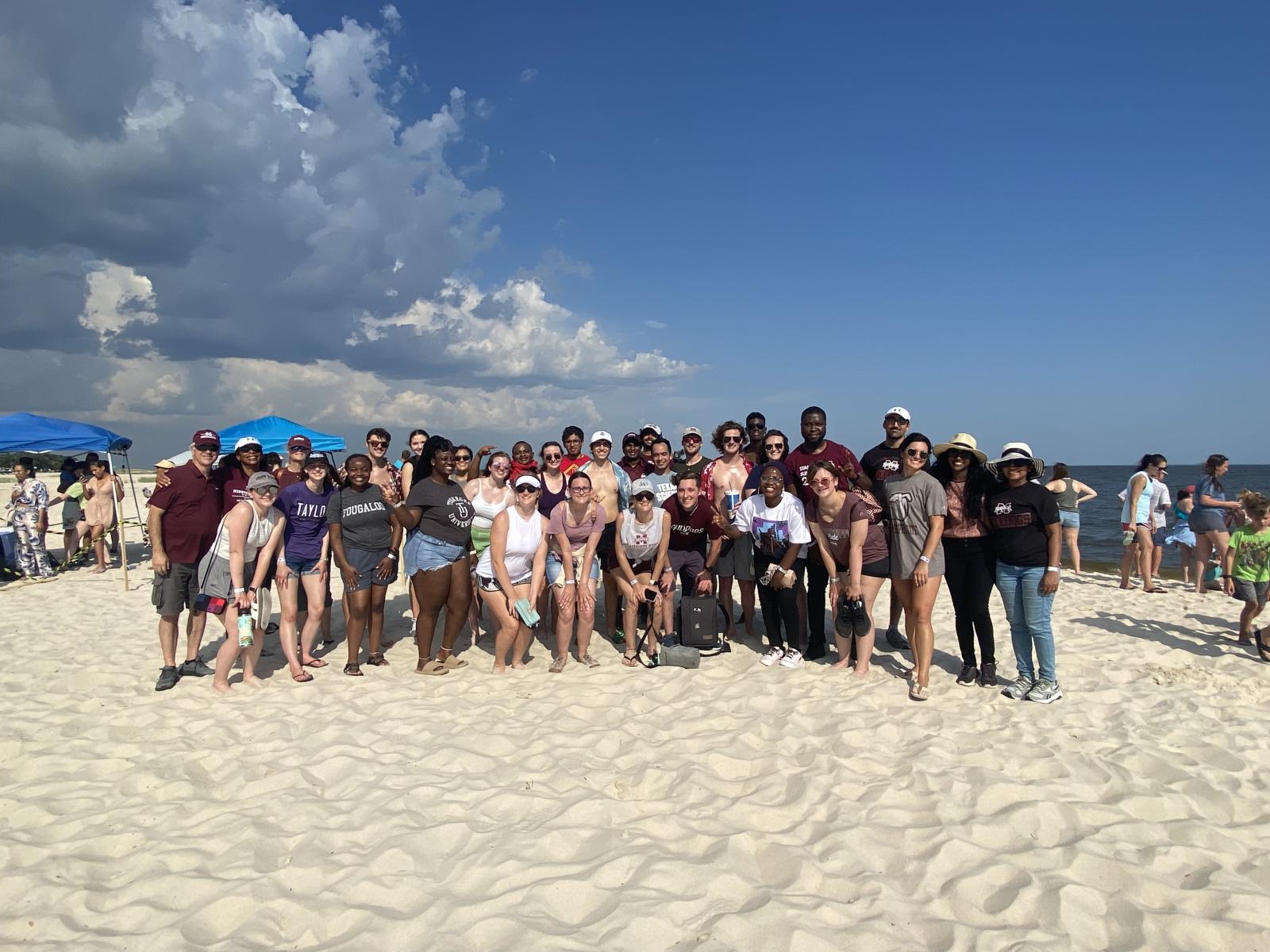
The June 2022 sea turtle release brought together students, staff, and faculty alike to watch the Kemp's ridley sea turtles swim back into the ocean after being rehabilitated through the Marine Mammal and Turtle Conservation, Recovery, and Monitoring Program. (Photo provided by Todd Mlsna)
By Alaina Dismukes
Twenty-five Kemp's ridley sea turtles found themselves in ice-cold water and their lives in jeopardy, but thanks to Mississippi State University and the Institute for Marine Mammal Studies (IMMS), the turtles were nursed to good health and swam back into the ocean during a June 2022 turtle release in Gulfport, Mississippi.
These endangered sea turtles were found cold-stunned in the New England area in December 2021. They were then flown to Gulfport by Sea Turtles Fly 2 to be rehabilitated through the Marine Mammal and Turtle Conservation, Recovery, and Monitoring Program, which is managed by MSU’s Global Center for Aquatic Health and Food Security (GCAHFS) as a collaboration between MSU’s College of Veterinary Medicine (CVM) and IMMS.
“The turtle release was excellent,” said Debra Moore, MSU assistant clinical professor. “The turtles swam away well and had no problems once placed in the water of the Mississippi Sound. All went well and the public response was great.”
How the cold-stunned turtles were rehabilitated
Cold-stunning can happen annually. Oftentimes, extreme weather fluctuations will cause the water’s temperature to drop suddenly, causing sea turtles to have a hypothermic reaction.
“Normally, sea turtles travel back south to warmer waters, but these did not,” Moore said. “They were found and kept at the New England Aquarium before coming to us since they had too many to care for.”
Sea turtles will become cold-stunned when water temperatures drop as low as 50 degrees.
“As reptiles, sea turtles’ body temperature fluctuates based on their environment, so when they become cold-stunned, it shuts down some of their metabolic processes,” she said. “They stop swimming and float, and they will ultimately die if not treated.”
The rescued Kemp's ridley sea turtles, which are the most critically endangered sea turtle in the world, had freeze burn topically and some had pneumonia.
“The sea turtles were first gradually warmed back up, and then once they were sent to us, we did all the diagnostic work such as blood work, X-rays, CT scans, etc., depending on what is needed medically,” Moore said. “Some had pneumonia with secondary infections from being out in the cold, so we treated them with appropriate medications and if dehydrated with fluids to rehydrate them. Depending on if they had fungal or bacterial infections, they were treated with appropriate medications and therapies.”
Once the sea turtles are healthy, they are medically evaluated and cleared for release by the MSU Sea Turtle Health Steering Committee. One of the main goals of the Marine Mammal and Turtle Conservation, Recovery, and Monitoring Program is to rescue, rehabilitate, and release the turtles back into the wild.
“It is important that these endangered species are put back into the ocean,” she said. “We make sure they are able to successfully thrive in the wild. Ultimately, the goal is to return them back to their natural habitat to be able to reproduce and contribute to the successful increase of the population.”
A great opportunity for MSU students
Students, staff, and faculty joined the June event to release 10 out of the 25 turtles. Nine of the 25 turtles were released in April, with participation of MSU CVM faculty, staff, and students. The remaining 6 turtles continue their rehabilitation under MSU CVM care.
Deb and Todd Mlsna, who both run the National Science Foundation Research Experience for Undergraduates Program, took 27 undergraduate and graduate students from MSU to attend the sea turtle release.
“Our 10-week undergraduate research program is for underserved populations in STEM (minorities, women, first-generation students), and this program has research collaborations with the Marine Mammal and Turtle Conservation, Recovery, and Monitoring Program,” said Debra Mlsna, associate professor in the MSU Chemistry Department.
“We collaborate through the CVM with other departments on campus for work related to the samples collected from sea turtles and dolphin tissues,” Moore said. “We work with the Chemistry Department on microplastic evaluation. We also work with the Mississippi State Chemical Laboratory for toxicological studies. Not only are CVM and chemistry students welcome to join these turtle releases, but all departments campus-wide are invited too. It’s a great opportunity for students to participate in. It’s also a great chance to visit the Gulf Coast of Mississippi and check out the environment that these sea turtles live in naturally. It’s fun, educational, and heartwarming to see a species that could have gone extinct return home.
“It makes all the difference when any human being makes a connection with an animal, and that is one of the powerful experiences that you receive at a sea turtle release. When a student is able to hold a turtle and see what they look like up close, there is that human-animal bond, and it makes all the difference in how the animal is perceived, and it ultimately impacts two lives. It’s a beautiful experience.”
Published July 28, 2022